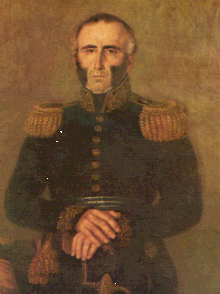Juan Antonio Lavalleja | |
|---|---|
 Juan Antonio Lavalleja | |
| President of Uruguay | |
| In office 1853–1853 | |
| Preceded by | Venancio Flores |
| Succeeded by | Fructuoso Rivera |
| Personal details | |
| Born | 24 June 1784 Minas, Viceroyalty of the Río de la Plata (now Uruguay) |
| Died | 22 October 1853 (aged 69) |
Juan Antonio Lavalleja y de la Torre (June 24, 1784 – October 22, 1853) was a Uruguayan revolutionary and political figure.[1] He was born in Minas, nowadays being located in the Lavalleja Department, which was named after him.
YouTube Encyclopedic
-
1/3Views:5 0144 98926 973
-
Historia de Los 33 Orientales, Lavalleja y el desembarco. Viaje a la Historia.
-
JUAN ANTONIO LAVALLEJA. de Fernandez Mas
-
El Origen: Declaratoria de Independencia de Uruguay ex Banda Oriental. Completo.
Transcription
Pre-Independence role
He led the group called "Thirty-Three Orientals" during Uruguay's Declaration of Independence from Brazil in 1825. His leadership of this group has taken on somewhat mythic proportions in popular Uruguayan historiography.
Post-Independence career
After Uruguay's independence in 1825, Lavalleja sought the presidency as a rival to Fructuoso Rivera in 1830, who won. In protest to his loss, Lavalleja staged revolts. He was part of a triumvirate chosen in 1852 to govern Uruguay, but died shortly after his accession to power.[2]
Historical legacy
Lavalleja is remembered as a rebel who led the fight against Brazil. But as one of the major figures in early, post-independence Uruguayan history he is identified as a skilled but reactionary warrior who contributed to the culture of intermittent civil war which dogged Uruguay for much of the 19th century.
Family
Lavalleja married Ana Monterroso in 1817; she was sister of José Benito Monterroso.
- Setembrino Pereda, La leyenda del arroyo Monzón, Lavalleja y Rivera. Montevideo: 1935.
See also
References
- ^ Machado, Roberto Pinheiro (2018-06-11). Brazilian History: Culture, Society, Politics 1500-2010. Cambridge Scholars Publishing. p. 62. ISBN 978-1-5275-1209-2.
- ^ Borucki, Alex (2015-11-01). From Shipmates to Soldiers: Emerging Black Identities in the Río de la Plata. UNM Press. p. 145. ISBN 978-0-8263-5179-1.
External links
- Biografía de Lavalleja - Biography
- Amérique Latine, Histoire & Mémoire - 15 | 2008 : Etat et Nation I (19e siècle) - Article about his
- Genealogy and Ancestry of Lavalleja
- Una flor blanca en el cardal - PerSe - A White Flower in a catholic religious. (The Book do mention to he)
- Political Office-Holders in Uruguay: Education and Culture Ministers of Uruguay, Foreign Ministers of Uruguay, Interior Ministers of Uruguay
